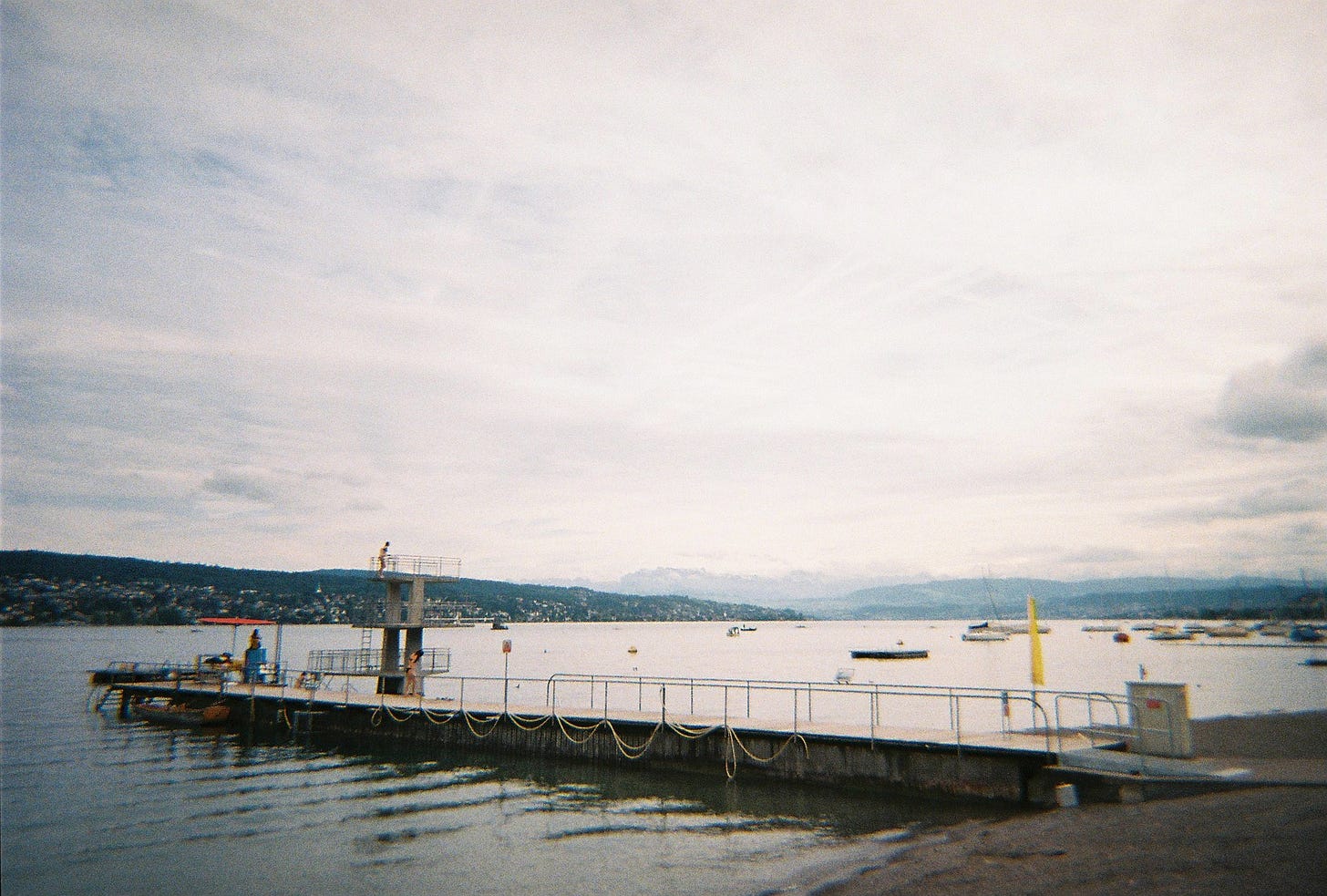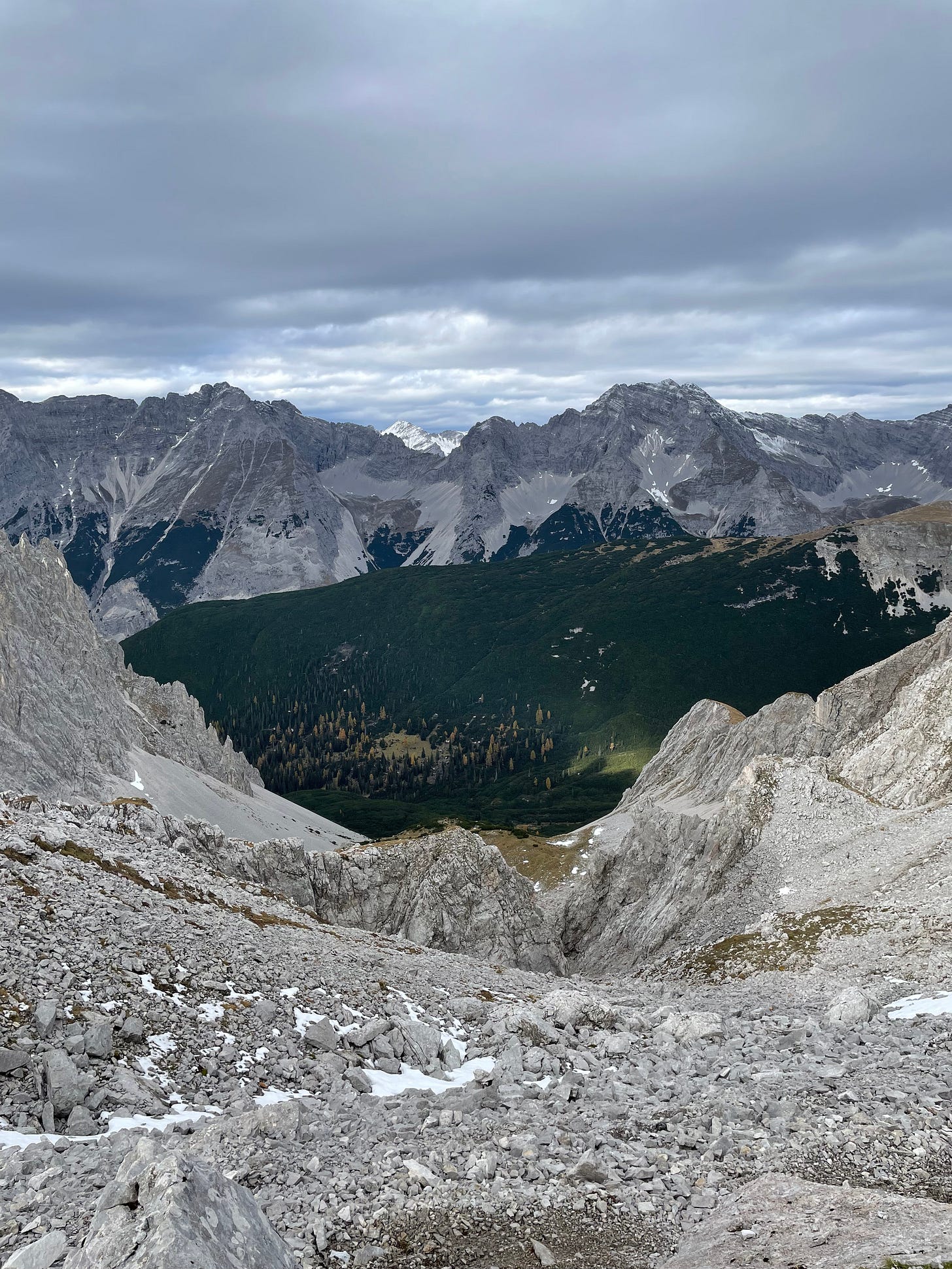The longer you are up there the higher it will feel. This is a universal rule of diving platforms—no exception is made for the Alps.
The view from the top is of boats and distant cliffs and glinting water and piers and bucolic shores and old Swiss women drip drying on the pontoon, waiting for you to jump. When the sun burns through the clouds it’s like standing in a postcard.
‘You will be the last people to do this,’ the lifeguard calls up. It’s not immediately clear that she just means for the season. The Swiss can be cryptic. When we said we live in Sydney, Australia, the lifeguard asked how far that is from Nimbin.
The diving platform is an island. You have to swim there, through the glacier water, and climb a hard metal ladder that bites into the bottom of your feet. Nothing pretty in Switzerland is for free. We will soon learn this lesson the expensive way, in shops and churches and restaurants, but we’ve only just dropped our bags. Flew in over the Alps this morning, which appeared unannounced out the starboard window, after 24 hours of flying, like a jetlagged fever dream. Snowy peaks piercing waves of waferish clouds. Commanding attention. Calling to adventure.
I take one last look at the mountains and step off the platform’s edge.
Uetilberg looms over Zurich and its lake. A steel lattice viewing platform looms yet further, thirty chilling and dizzying metres above the mountain’s god given peak. Railings have ice on them. Noses, eyes, freely gush. Quite a view though. Photos lack dimensions. It’s as if the whole world falls away in blues and greens.
From there we hiked to Falsenegg along the ‘Planet Weg’, a path with plinths that map out a scale model of the solar system. The sun was a beachball. The whole Earth, hundreds of metres away, smaller than a pea. And it’s not just the relative sizes of the planets but the distance between them that is amazing. Which is something I mentioned a lot. Which did not endear me to my fellow hikers on the many gravelly, undulating kilometres that passed between the gas giants.
Thin mists were dappled by morning sun. Trees blew in autumn breezes. Our astronomy lesson was punctuated by glimpses of the Alps through the treeline. When the view really opened up I’d point my phone at it, hoping a good enough picture might also capture every swirling internal experience of humbled confusion and contentedness and cosmic insignificance and relief at not being at work and fear of going back to work and love and oneness and wonder. I could never quite get it all in. I think my phone’s too old.
As we approached Falsenegg, the overwhelming feeling was that the Solar System is too big. And too hilly. Near Mars we’d seen a cyclist surrender to a steep incline and swear in breathless Swiss German—by the time we rounded Uranus we knew something of the feeling.
I’m not proud of some of the things I said (or gestured) to Pluto. I can only blame it on the Mountain Madness.
The buses that service Lake Como’s many forks have a kind of magic to them. Dark magic. Just when you think the thing is finally full beyond all acceptable limits of public safety, personal hygiene, basic physics, the driver—always a young guy, always bearded, always talking on the phone—will slam to a halt to admit more crushing humanity. As long as the doors can physically close, he’ll take off again. And not slowly. The streets that tumble and turn along the lake wring two directional, fast moving traffic around bends that lurch and sicken, up hills that are mountains unto themselves.
The road itself is as potholed as it is precarious. On one side there’s concrete walls, mossy bricks, cyclists, pedestrians. On the other side, certain picturesque death. Picturesque because sometimes, as I am queasily yanked and hauled in the hot rumbling bus, I see the lake and its electric blue fields. Cute colourful towns crawl up the shore. Boats split the river in twain. Birds nest, soar. And there are bright green mountains in rolling splendour for as far as the eye cares to see.
It is a basic law of holidays that the more painful the journey, the better the view will be when you arrive. In Switzerland the Alps were too easy to come by. So it is nice, in a way, in Lake Como, to suffer for our photographs.
In Bellagio and Varenna, once the colour has returned to my face after the rollercoaster bus, we find enchanting alcoves, roses in full bloom. In Nesso, we hike impossibly steeply downwards to an old stone bridge that is wrapped in vines and rich autumn leaves. In Brunate, after twenty minutes on a funicular, we trudge another thirty almost vertically up—past a few well-signed, publicly accessible defibrillators—to Volta’s white stone lighthouse. At the peak, once our breathing regulates and our vision unblurs, the curves of Como unfold down below. We watch its valleys cradle a low, red-sun.
Though a part of my mind must think about the walk back down the cliff, in rapidly fading light, with already aggrieved knee ligaments, the rest of me can look out at the mountains that wrap the lake. Digest their magnificence in the dusk. Know their bigness, sureness. And be glad to have lived in their shadow.
I’m not crazy about cable cars. I can’t believe that anyone is crazy about cable cars. The Nordkette cable car starts 860 metres above sea level, and from there goes two kilometres pretty much straight up. The cabin is thick with people. It swings uneasily on the wires. The attendant sits in a little booth chewing his nails, tossing the scraps out the open window.
It takes you to a town that will market itself as the ‘Top of Innsburck’, but will feel more like the top of the very world.
Hafeleker is a sheer, rocky peak pocked with fresh snow. Its view melts the mind—in that, for the first few minutes, our brains seemed to think they were experiencing vertigo. The steepness, the altitude, the enormity of it all. You will look for things to hold on to. You will feel that something has gone fundamentally wrong with the tilt of the universe.
I think someone used the word ‘inconceivable.’ And yet a good amount of time is spent on the peak trying to conceive it, to make sense of the MOUNTAINS with a camera or with adjectives and profanities. Can’t be done. Nothing can capture the scale. Or the wonder. Or how the many snow-capped peaks on the horizon feel almost close enough to touch. Or how the Innsbruck’s biggest buildings are too tiny to even make out. Or how a mountain puts everything in its place. Or how did anyone ever climb this thing, much less set up cable car infrastructure. Or how the forces of time and chance that made these mountains are the ones that made me too. Or how there is really nothing more important in the world than to be kind.
Mountain madness. It can drive you crazy to try to take a photo of a beautiful thing and feel your camera can’t ingest even a fraction of it. It’s much nicer and more affirming just to sit. There are benches all over the peak for just this reason. To let go of neuroses and money and phone and self and settle back against the pine. Look. Feel. Enjoy. Promise to find and do other things that feel like this.
I hope that lasts longer than the pictures. What a special thing it is to feel small.
MOUNTAINS is the first part of a small series on our adventures in Europe—METROPOLIS and MANKIND are maybe on their way soon.











Thanks Gus!
Loved it!
Brilliant Gus. Loved it. Chuckled a bit. Could see it. Great photos too. Looking forward to the rest of the series. You should enter this somewhere!!!